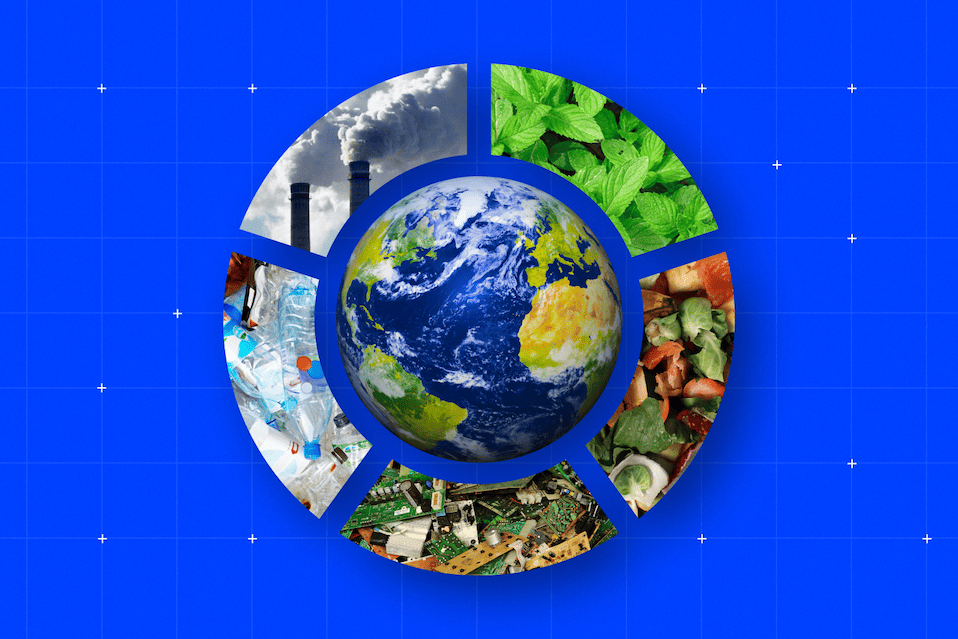As climate change and corporate transparency concern more and more investors QoQ, C-Suite leaders are now considering how they can transform their operations to be more ESG-conscious.
Now more than ever, authentic programs and initiatives founded in prioritizing the environmental, social, and governance impact of supply chains prove to be one of the best ways to win over consumers, investors, and their capital—especially during an economic downturn.

But while attaining an ESG-stock label is a must for any company looking to survive a volatile market, some leadership execs question how ESG translates into how they run their business.
Below, we dive into the nitty-gritty of ESG, provide context into what it looks like at a corporate level, and dive deep into the major companies leading in their ESG initiatives.
Waning Faith in ESG Authenticity
The intentions behind ESG investing are altruistic: to influence the mainstream finance industry into funneling private capital to address global challenges. However, leading private equity firms have recently been accused of manipulating investors through various misleading schemes to cash in on the trend.
Investigations into major financial institutions have led to a growing demand for vetting processes for companies ascribing ESG to their policies. And while the SEC and ISSB‘s involvement has brought more authoritative figures into this issue, investors are still primarily responsible for determining whether a company or ESG fund is honest in its intentions.
Without an official system to check an organization’s commitment to its ESG policies, many shareholders and investors are doing their due diligence through fact-checking. From reviewing how a company is publicly rated as “ESG-friendly” to the supply chains they use and even the processes regulators utilize, there’s a myriad of aspects investors are analyzing to improve their responsible investing criteria.
ESG Frameworks
When considering how you can implement an ESG strategy authentically, there’s an opportunity to modify every aspect of your operations to be more socially and eco-conscious.
Below, we dive into the most common approaches businesses are taking:
- Greenhouse Gas Protocol: There’s no underplaying the global climate crisis scientists warn of—and the part companies play in it. To ensure your operations are not contributing greenhouse gas (GHG) emissions, prioritize green computing initiatives and other sustainability efforts. CIOs should research Greenhouse Gas Protocol frameworks that standardize how enterprises report and manage greenhouse gas emissions. A good first step is learning the basics of scope 1, 2, and 3 emissions.
- Circular Economy: Today, stakeholders, from consumers to software vendors, are concerning themselves with extending a product’s lifecycle via the circular economy model—a model of production and consumption where items and products are reused whenever possible rather than discarded. CIOs and other leaders need to explore how to incorporate a circular economy approach, such as ways to innovate product design and the end-of-life aspects of how they build IT systems.
- Honest Carbon Reporting: The biggest challenge corporations face is the narrative they want to tell to their shareholders, a.k.a reveal their carbon footprint and other ESG metrics. While some business leaders may want to minimize their GHG impact, the truth, as aforementioned, always comes out. New regulations for greenhouse gas emissions ask companies to be thorough in capturing the full extent of their emissions, which is why it is essential to think about how you can share your results across various audiences.
Note: While reducing Scope 1 emissions may be more tradeable on carbon exchanges, limiting Scope 2 and Scope 3 emissions can also have a positive impact on the reporting narrative you share with regulators and investors. Some of the largest banks are devising how to channel indirect investments out from more carbon-intensive industries toward industries that are actively reducing emissions.
- Green IT: IT services prioritizing environmental sustainability are playing a major part in the climate action movement. Consequently, CIOs need to foster green IT environments, especially in tech-heavy industries like banking, finance, and telecommunications. It’s these industries where IT investments have an enormous impact on a company’s carbon footprint—investments that will pay off in the long term due to emerging government regulations.
Note: Green IT is a big part of the U.S. Energy Act of 2020, which raised power usage effectiveness (PUE) requirements. Some of the top objects of PUE programs include migrating to more sustainable energy systems, better usage tracking, and more automated energy controls. Many companies are working to adopt green computing best practices, such as redesigning or consolidating data centers, migrating to the cloud, and autoscaling workloads, to minimize their energy footprint.
Leaders of ESG Reporting
Disney
Disney’s reporting discloses multiple ESG-oriented frameworks including the Global Reporting Initiative (GRI), Sustainability Accounting Standards Board (SASB), CDP, and Task Force on Climate-related Financial Disclosure (TCFD). Many consider Disney to be highly transparent in its disclosure by ESG rating providers—however, the report offers no level of third-party assurance of the data.
However, Disney is a leader from an emissions perspective. While many companies focus on a reduction in greenhouse gas (GHG) emission intensity, Disney has been able to decrease its absolute Scope 1 and 2 emissions and total energy usage from 2018 to 2020. In 2020, Disney met its target to reduce GHG emissions by 50% from 2012 levels. Disney’s parks and experiences offer customers a variety of restaurants, which generate food waste. The company recognized a desire to send less total waste to landfill and implemented extensive programs focused on food waste capture, material sorting, and the reduction of plastics and unnecessary waste.
“Our strategy for achieving net zero for Scope 1 and 2 emissions by 2030 is based on a science-based reduction hierarchy. The target is derived from TWDC’s 2030 target to achieve 100% zero-carbon electricity, as noted in C4.2a. We define zero-carbon electricity as any type of electricity generation that does not generate net greenhouse gases such as solar, wind, and geothermal resources, but also includes existing zero-carbon assets on the grid, like nuclear and large-scale hydropower. Included in this target is all purchased electricity, including electricity used on-site to generate chilled water.”
– Disney, Corp. | Climate Change 2022
“We will achieve these results through a comprehensive waste management plan that relies primarily on reducing waste on our properties, including food waste; reusing products and materials; being deliberate about material sourcing; maximizing recycling; and focusing on education efforts with our guests and employees. In our highly varied and complex operations, some waste may be unfit for these preferred diversion efforts. In these cases, we may supplement those efforts with waste-to-energy solutions where environmentally and socially responsible options exist. We will work with other organizations in our communities to research and test emerging technologies that can eliminate or reduce waste.”
– Disney, Corp. | Climate Change 2022
PepsiCo
As one of the largest soft drink retailers in the world, PepsiCo wants to have a positive influence on the diets of people around the world by providing products that deliver vital nutrients across food groups and are trusted to meet high safety and quality standards.
Currently, the company offers food products with whole grains, nuts, seeds, fruits, and vegetables as well as complimentary beverage options like water and unsweetened tea, which support hydration without adding calories.
PepsiCo has made specific efforts to improve the nutritional profile of many of its products by reducing added sugars, sodium, and saturated fat while investing in innovation to deliver important food groups and nutrients to encourage a balanced diet for its consumers.
They’ve reconsidered their serving sizes, developing innovative packaging solutions that reduce their carbon footprint and avoid waste, working to provide simple, clear information on their packaging, and exploring ways to empower consumers with transparent environmental labeling on their key products by 2030.
“Product innovation towards lower environmental impact is an area continuously explored by our R&D teams including supporting our journey towards our sustainability goals like our product nutrition goals around reducing added sugars, sodium and saturated fat, our sustainable packaging goals including researching recyclability solutions and incorporation of recycled content in our product packaging, all of which are also closely tied with our climate strategy and lead to GHG emission reductions.”
– PepsiCo | Climate Change 2022
Starbucks
SCS Global Services collaborated with Starbucks to develop the Coffee And Farmer Equity (C.A.F.E.) Practices standards to ensure that Starbucks is “sourcing sustainably grown and processed coffee”. In terms of sustainability, the coffee retailer uses an economically viable model that addresses the social and environmental needs of all the participants in the supply chain, from farmer to consumer.
Starbucks’s C.A.F.E. standard promotes transparency, profitability, and responsible coffee-growing and coffee-processing practices while improving the livelihoods of coffee farmers and workers and conserving natural habitats for communities. To date, the company’s C.A.F.E. Practices Generic and Smallholder Scorecards encompass a comprehensive set of more than 200 social, economic, and environmental indicators that are assessed in third-party audits.
“From 2015 to 2019, 99% of Starbucks coffee was verified as ethically sourced as measured by C.A.F.E. Practices, our ethical sourcing verification program developed in partnership with Conservation International. Measuring farms against economic, social, and environmental criteria, the program is designed to promote transparent and sustainable coffee growing practices while also helping protect the well-being of coffee farmers and workers, their families, and their communities.”
– Starbucks Corp. | Climate Change 2022
Maintaining Your Market Value
ESG assets are forecasted to generate $53 trillion in valuation by 2025. With new regulations emerging to target ESG risks like greenwashing, and the importance of performing ongoing due diligence on new developments in the ESG space, an all-in-one market intelligence platform is critical to stay on the leading edge and keep making well-informed decisions.
ESG is no longer a nice to have—it is now a necessary piece of criteria that both investors and consumers are incorporating into their purchasing decisions. Today it is challenging to research and benchmark performance due to the lack of standardization. Download our infosheet, The Top 4 Market Intelligence Sources for ESG Research to discover where to find reliable and timely ESG insights.
AlphaSense helps you cut through the noise and delivers meaningful insights from over 10,000 content sources including company reports, broker research, news sources, and expert interviews, so you can uplevel your risk management and investment strategy today.
.png)







